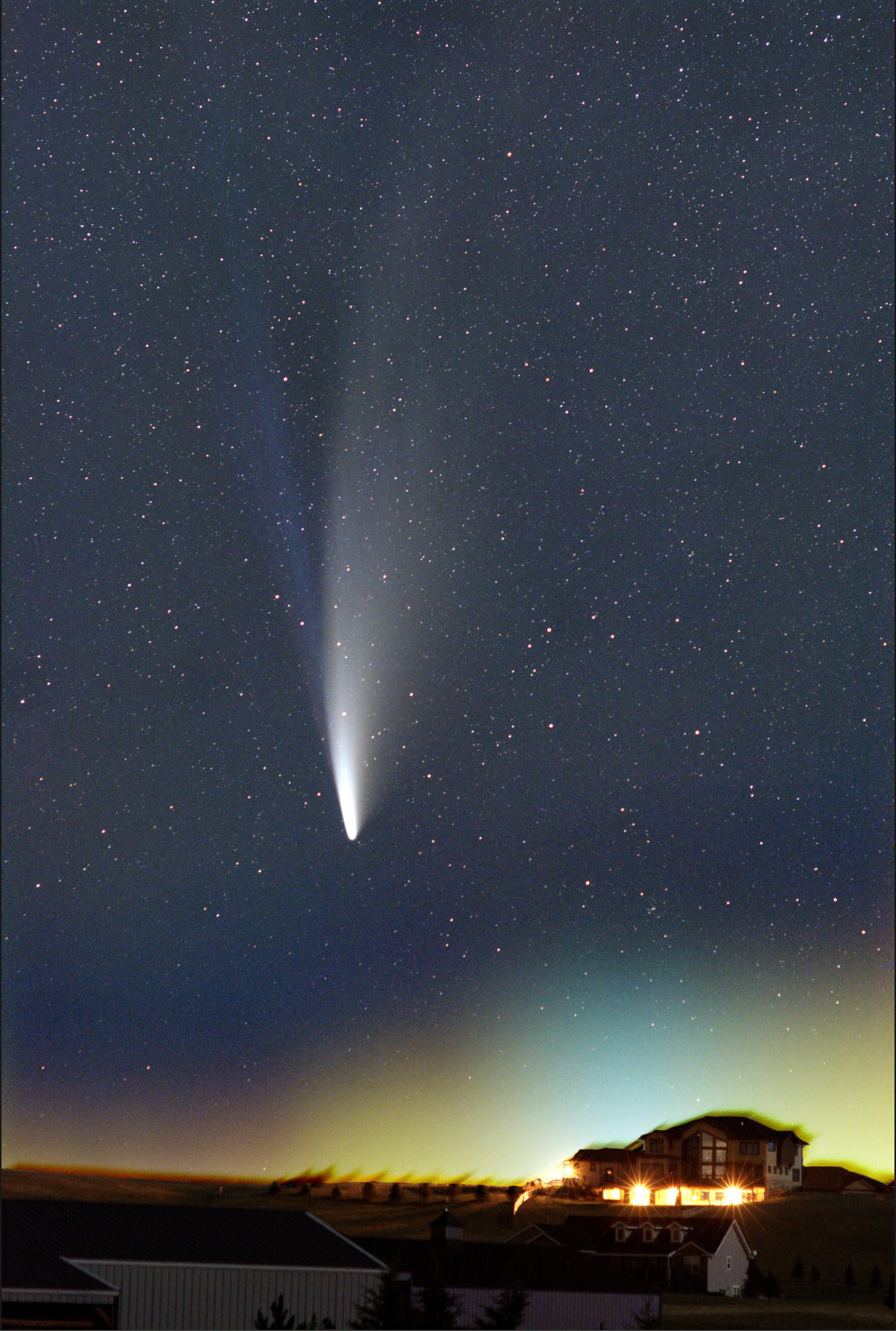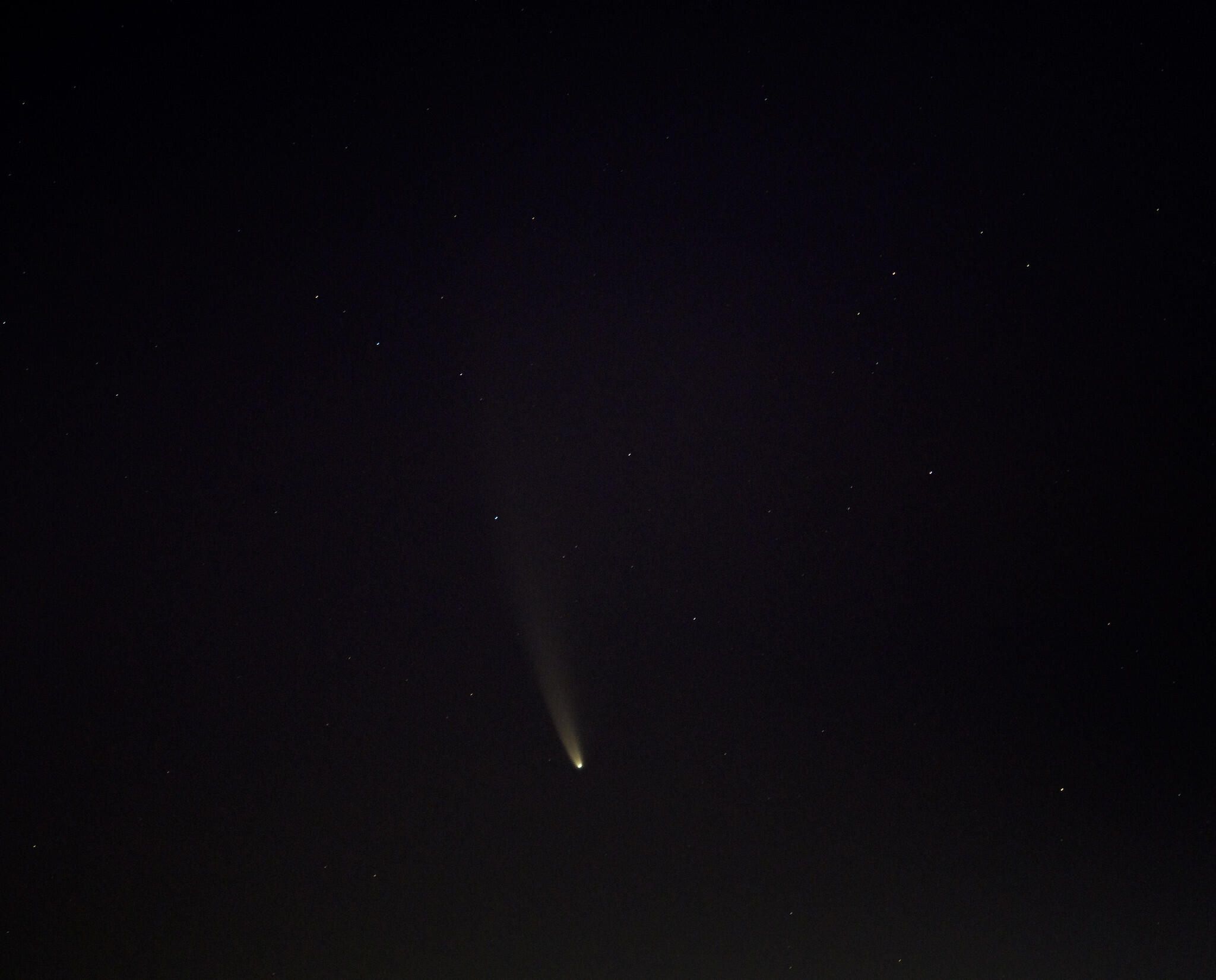

This NASA image from the Parker Solar Probe uses processed data to show comet Neowise’s twin tails.
NASA/Johns Hopkins APL/Naval Research Lab/Parker Solar Probe/Guillermo Stenborg
NASA says comet Neowise is the brightest space iceball to fly by Earth since at least 1997, and it’s now putting on a show in the evening sky, sending hopeful astrophotographers out into the dark.
Plenty of gorgeous images of the comet appearing over the horizon just before sunrise or shortly after sunset have been circulating online, even as most people still were needing binoculars to locate the speeding space visitor. This leads to an obvious question: How the heck did they get those great shots?

Neowise over Cheyenne, Wyoming on July 12.
Spaceweather.com/Jan Curtis
It takes a little planning and patience, but with the right equipment and a little cooperation from the weather, just about anyone can do it. Here are some basic tips to get you started.
Pick the right time and place
During the rest of its run, comet Neowise will appear primarily in the northwest and western evening skies. See my earlier post for more details on exactly where to look or use an online sky mapping tool like TheSkyLive.com for your time and location.

Where to look for Neowise in July.
NASA/JPL-Caltech
Once you know which direction to face, you’ll need to get as far away from all light pollution as possible and make sure you’ll have as clear and broad a view of the night sky as you can find. Clouds and city lights can really ruin your astrophotography plans.
Some more intrepid photographers have taken to late-night or early-morning mountain climbs to get the best vantage points possible, often with remarkable results. Just be sure to prepare and be safe if you’re going to make an expedition out of it.
Grab your gear
While a comet zips through space at 17,500 miles per hour (28,159 kilometers per hour), it appears almost stationary from our perspective. That means photographing Neowise is about precision and long exposures rather than any sort of action shots. As such, you’ll need a sturdy tripod and a camera with a good telephoto zoom lens. You’ll need to be able to set the lens and camera to manual focus and exposure, as well as use a Bulb, Time or long-exposure preset mode to handle the exposure. If you really want to go the extra mile, use a camera with a shutter release cable, self-timer or some other remote operation capability to prevent any shaking or blurring that might come from pressing the shutter button.
It doesn’t hurt to bring a wide-angle lens as well. The tail of a comet can take up a wide enough area that a zoom lens might not always be practical. That’s how many have been able to grab especially stupendous images of both Neowise and the aurora borealis.
“I was excited to see my wide-angle lens could capture the span from STEVE (an aurora-related phenomenon) to Neowise, and got about 10 photos,” Manitoba-based photographer Donna Lach told NASA. “I observed the incredible aurora for about three hours, and it sometimes stretched above me. At times Neowise was outshone by the brilliant aurora, but it was visible the entire time.”
Experiment!
Once you’ve found the right spot, located the comet and set up your equipment, the real work begins. First, ditch auto-focus on your camera and play with different focal lengths, exposure times and frame compositions. You might want to isolate the comet, or capture it against the landscape.
When NASA’s Bill Dunford photographed the comet while it was visible with the naked eye before dawn, he found a certain sweet spot for getting the best images.
“I zoomed in on it and exposed each shot for about four seconds,” he explains in the above video.
Trust the processing
We live in a photoshopped world, but with astrophotography you can use image processing to make Neowise look more as it appears in person.
This will again require some experimentation and good image-editing software, but Dunford advises playing around to see if you can brighten the image and bring out the brilliance of the comet and reduce noise. This is more likely to be how your brain actually processed the image received from your retinas in real life.

Neowise over Washington, D.C.
NASA/Bill Ingalls
Share the wealth
Be sure to share whatever you capture with the world. Some of us are staring down a forecast of cloudy evening skies for the next week, despite living in the southwest desert. Please share your images with me on Twitter and Instagram @EricCMack.




